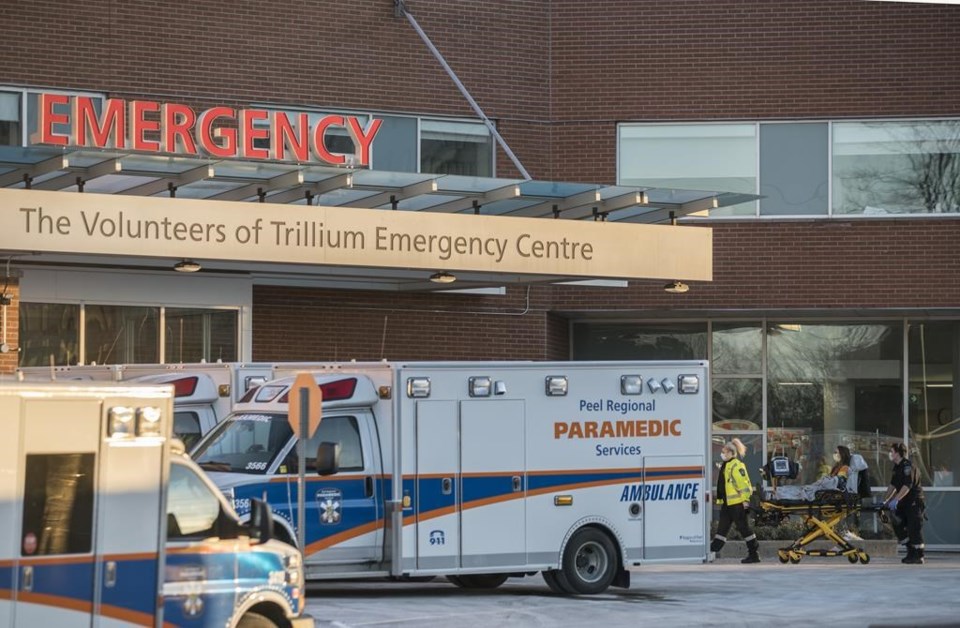Ontario reported 412 COVID-19 patients in intensive care units on Sunday, a jump from 385 a day earlier, as health-care workers in the province continue to feel the strain of an Omicron-fuelled wave.
Dr. Mike Haddad, Chief of Staff at Bluewater Health in Sarnia, Ont., said his hospital is currently seeing higher levels of COVID-19 admissions than at the peak of the first wave in April 2020.
The hospital's previous record was 33 COVID-19 patients at one time, a figure surpassed Sunday when its 34th was admitted. Eleven of those patients are battling severe disease in ICU — "many of them on life support," Haddad said — noting 10 of them are unvaccinated.
"What worries us is all the talk about (Omicron) as a milder variant, that's great. But even though it's milder, there's so many more infections that the balance is basically washed out," he said. "We're back to Square 1 in terms of having a dedicated COVID unit again, ICU's full of COVID, surgeries cancelled, surgical staff redeployed to help deal with this.
"So to us, milder or not, it's the same detrimental effect on the health system."
Ontario reported 2,419 patients hospitalized due to the virus on Sunday, down from Saturday's count of nearly 2,600. Not all hospitals report their numbers on the weekends.
The province also reported 20 new deaths linked to the virus as the seven-day average of COVID-19-related patients in ICU rose to 322.
Haddad said his Lambton Public Health Unit, along with neighbouring Chatham-Kent, began seeing an increase in COVID-19 hospitalizations around December, earlier than the rest of the province.
He attributes the surge to many factors, including an older population and lower vaccine uptake than other areas in Ontario.
Vaccines have been working exceptionally well to reduce hospitalizations and deaths, Haddad added, noting that with thousands of COVID-19 cases in his community, his hospital would have been "completely overwhelmed" without them.
"That's the one thing people don't think about," he said. "They look at how many in the hospital are vaccinated or unvaccinated, but imagine if nobody was vaccinated in the community — our numbers at the hospital would be astronomical."
Haddad said that while his staff has remained in high spirits, they're exhausted by Omicron's incessant spread. Roughly five per cent of them are currently isolating after an infection or high-risk exposure.
Staffing shortages, which many hospitals are reporting, can have trickle-down effects that alter the flow of other health-care services, including paramedics, he said.
A full emergency department means paramedics can't offload patients quickly, and can't be deployed to the next call.
"It's all connected," Haddad said, adding that while he hasn't seen that happening yet in Sarnia, it is already unfolding in other regions of the province.
A union representing paramedics in Toronto tweeted a "Code Red" alert on Saturday night, saying there were no response units available in the city around 7 p.m.
TPS Unit Local 416 vice chair Peter Shirer didn't know how long the status lasted, but called it a symptom of a decade-old problem that's now being exacerbated by Omicron.
Provincial data showed 11,959 new COVID-19 cases Sunday, but Public Health Ontario says the actual case count is likely higher due to current testing policies that limit access for many residents.
Shirer estimated 10 per cent of Toronto paramedics may currently be isolating. That, coupled with an increase in virus-related call volume, has taken its toll.
"There's a lot more pressure with us servicing calls right now in the fifth wave of a two-year-long pandemic," he said, adding that while he didn't have statistics on how often code reds are called, "it certainly seems anecdotally that we have a higher incidence of greater strain on the medics I represent."
Brad Ross, chief communications officer for the City of Toronto, said in an emailed statement that it's not uncommon for all ambulances to be on call one moment and freed up the next.
Ross said Toronto Fire Services has been responding temporarily to a number of low-priority calls. But if a patient needs a paramedic, Toronto Fire will call for them.
"There remains significant pressure in hospitals resulting in paramedics being delayed with off-loading patients," Ross said. "This issue is unfortunately common right now around the world."
Toronto's paramedics aren't the only ones dealing with recent Omicron-related strain.
Durham Region tweeted on Wednesday that there were "no ambulances on the road" at one point on Tuesday, with crews from York and Kawartha Lakes brought in to respond to two calls.
Elsewhere, Federal Emergency Preparedness Minister Bill Blair said Saturday that members of the Canadian Armed Forces had arrived in Bearskin Lake, a First Nation in northern Ontario gripped by an outbreak of COVID-19 that has infected more than half the population.
Blair said in a tweet that the soldiers are conducting an initial assessment.
The chief of Bearskin Lake, Lefty Kamenawatamin, said Friday that the remote community was "almost at a breaking point" and asked ministers to send urgent aid.
This report by The Canadian Press was first published Jan. 9, 2022.
Melissa Couto Zuber, The Canadian Press

